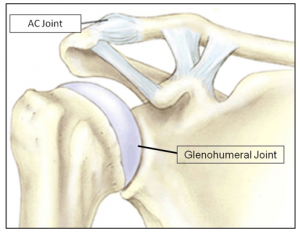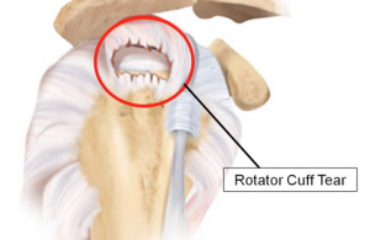What is the anatomy of the shoulder?
Your shoulder is a ball and socket joint that connects the humerus (upper arm bone) to the clavicle (collarbone) and  the scapula (shoulder blade). Because of its configuration, you can freely move your shoulder across a wide range of motion.
the scapula (shoulder blade). Because of its configuration, you can freely move your shoulder across a wide range of motion.
The shoulder has four rotator cuff muscles that provide stability to the shoulder joint as it moves. The four rotator cuff muscles (supraspinatus, infraspinatus, teres minor, subscapularis) keep the humeral head centered in the socket of the shoulder joint (called the glenoid fossa).
Your shoulder also serves as an important attachment for numerous muscles that allow the shoulder and arm to move, such as the deltoids, rhomboids, trapezius, among others.
What are the different kinds of shoulder injuries?
There are numerous conditions that can affect the shoulder, causing pain and limitation of movement. These can range from slow, degenerative conditions, to acute traumatic injuries. The presentation of these injuries varies with the injury, and it is recommended that you consult with a licensed medical professional if you think you have a problem with your shoulder.
Some examples of shoulder injuries are as follows:
- Tendinitis – Muscles are connected to the bone by tendons. Repeated micro-trauma, wear and tear, and repetitive injury can cause chronic inflammation of the tendons. Acute stressors can also cause injury and inflammation of the tendons. This manifests as pain in the shoulder and limited movement. The rotator cuff tendons are the most commonly affected by this condition.
- Tendon tears – Tears to the tendon can occur after acute injury, or after progressive degeneration. Tears can be partial or full-thickness, depending on the severity of the injury. Treatment is usually conservative, but surgical intervention is necessary for the more severe cases.
- Impingement – Soft tissues, such as nerves and tendons, can be pinched against the acromion (the bony top of the shoulder blade), particula
 rly when the shoulder is unstable. The pinching causes irritation and inflammation, leading to pain and reduced movement. Repeated irritation can cause tendinitis and bursitis, and can eventually lead to tears over time.
rly when the shoulder is unstable. The pinching causes irritation and inflammation, leading to pain and reduced movement. Repeated irritation can cause tendinitis and bursitis, and can eventually lead to tears over time. - Instability – The humeral head can be displaced from the glenoid socket, leading to an injury known as dislocation. The dislocation can be partial or complete, causing pain and damage to the tissues of the shoulder, particularly that of the rotator cuff. Those who suffer dislocations are more at risk for subsequent dislocations
- Arthritis – There are many kinds of arthritis, but the most common is osteoarthritis, which is secondary to progressive degeneration from wear and tear. This is associated with aging, and if left untreated, may even lead to stiffness and loss of range of motion.
- Fracture – this is usually after acute trauma to the shoulder joint. They often cause severe pain, swelling and bruising around the shoulder. Any of the bony structures of the shoulder can be fractured. Older patients and those with weak bones are at greater risk for suffering fractures of the shoulder.
How are shoulder injuries diagnosed?
You should seek consult from a licensed medical professional if you have problems with your shoulder. The diagnosis of your condition is made after a complete medical history and physical examination, although sometimes, additional imaging studies may be requested to provide a clearer picture of the injury. The commonly used diagnostics are X-rays, Magnetic Resonance Imaging (MRI) and Computerized Tomography (CT) scans.




